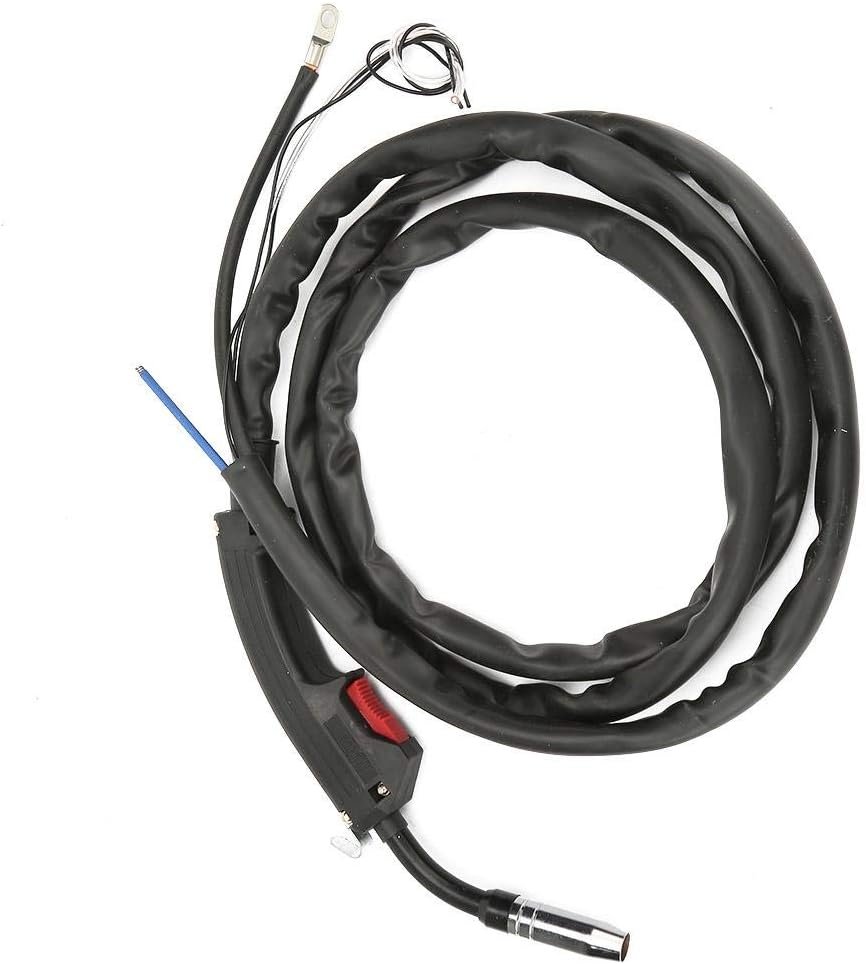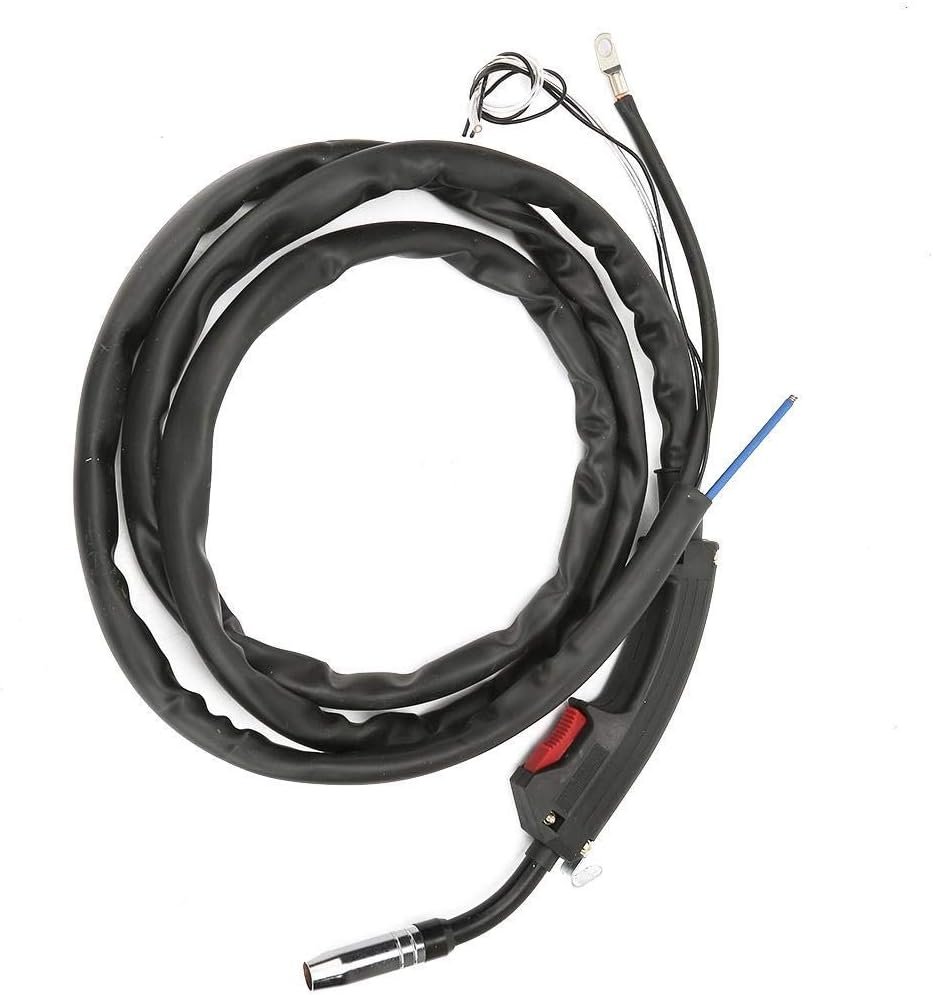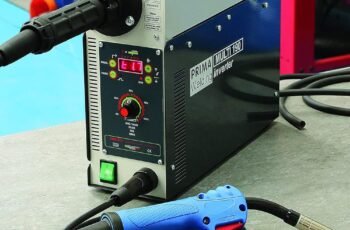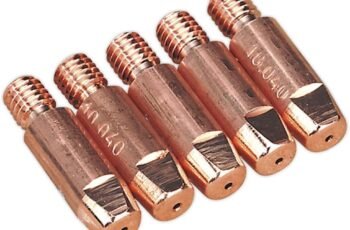Ad Blocker Detected
Our website is made possible by displaying online advertisements to our visitors. Please consider supporting us by disabling your ad blocker.
Looking for a reliable MIG torch that handles 160A–200A jobs with CO2 protection and solid build quality?
Product Overview
You’re looking at the 14AK MIG Welding Torch, MB14 CO2 Gas Protective MIG Welder Torch 2 Meters Welding Gun Parts Fit for Current 160A~200A because you need a simple, robust torch for protective gas welding. This torch is built to fit MIG130 connections and handle a moderate to heavy current range, making it a good match for many common MIG welding tasks.
Key Specifications
You’ll find the core specs below so you can quickly check fit and capability before you buy. The table breaks down the most important attributes you should compare to your existing setup.
| Feature | Details |
|---|---|
| Product Name | 14AK MIG Welding Torch, MB14 CO2 Gas Protective MIG Welder Torch 2 Meters Welding Gun Parts Fit for Current 160A~200A |
| Type | 14AK / MB14 style MIG torch |
| Fits | MIG130 torch connection / MIG130 systems |
| Working Pattern | Protective gas welding (CO2 compatible) |
| Operation Mode | Manual |
| Action Target | Metal |
| Current Capacity | Suitable for 160A ~ 200A |
| Wire Diameter Compatibility | 0.8 mm – 1.2 mm |
| Torch Length | 2 meters (cable length) |
| Material | Metal body and reinforced cable (premium material) |
| Typical Use | General workshop, light industrial, automotive, fabrication |
| Country Note | International product; labeling, packaging, or instructions may differ from local versions |
What’s in the Box
You’ll typically receive the torch assembly with a pre-attached 2-meter cable, a welding nozzle, contact tip compatible with 0.8–1.2 mm wire, and the necessary connector for MIG130-style machines. There may be minor variations depending on the seller or region, so check the listing to confirm included consumables and any extra adapters.
Design and Build Quality
When you handle this torch you’ll notice it’s made to resist the everyday knocks and heat exposure of welding. The construction concentrates on a metal body and robust cable to extend real-world service life.
Materials and Construction
You’ll find a metal torch head with reinforced fittings where the cable meets the handle to reduce stress and cracking. The internal gas and wire pathways are designed to be stable under heat and electrical load, which helps maintain consistent performance during a bead.
Ergonomics and Handling
You’ll appreciate the compact MB14/14AK head for access in tighter joints and around curved panels. The grip and trigger are straightforward and built for manual operation, so your hand fatigue should be manageable for medium-length tasks.
Cable and Length
You get a 2-meter cable that gives you decent reach around a standard workbench without added extension. The cable is reinforced and rated for the current range, but you should avoid kinking and sharp bends to prevent premature internal wear.
Performance
If you plan to run jobs that need steady arc and decent bead cleanliness, this torch is targeted to deliver reliable performance within its rating. It’s intended for CO2 or mixed gas shielded MIG processes on typical steel workpieces.
Current Capacity and Duty Cycle
This gun is specified for 160A–200A, so you can run moderate-to-high current welding jobs provided your supply and duty cycle match what you need. Keep in mind that actual duty cycle depends on the machine you pair it with, cable configuration, and ambient conditions.
Wire Feeding and Compatibility
You’ll be using 0.8–1.2 mm wire sizes, which covers most common mild steel applications and a number of stainless or flux-cored wires when matched to the correct gas and machine settings. The MB14-style contact tips and nozzle system are standard, so you’ll find replacements easily.
Arc Stability and Bead Quality
When set up with the correct wire speed, voltage and gas flow, you’ll get a steady arc and consistent bead appearance on typical joints. CO2 shielding tends to give a slightly more penetrating, hotter arc; you’ll adjust travel speed and wire feed to control bead shape and spatter.
Usability
You should be able to set this up and start welding relatively quickly if your welder accepts MB14/14AK-style torches. The manual trigger and simple nozzle system are good for both newcomers practicing technique and experienced users replacing a worn torch.
Installation and Setup
You’ll connect to a MIG130-compatible fitting and secure the gas and power lines per your welder’s instructions; the connector style is common. Check the contact tip size and gas nozzle orientation before feeding wire to avoid misfeeds and poor shielding.
Controls and Operation
You’ll use the torch trigger to control wire feed and welding arcs as usual, with no electronic controls on the torch itself. The trigger is typically a simple on/off style, so your welder’s settings will handle fine control like burnback, inductance, and feed speed.
Maintenance and Serviceability
You’ll find that consumables—contact tips and nozzles—are easy to replace without special tools. Regular cleaning of the nozzle to remove spatter and periodic inspection of the cable and connections will keep the torch working well for a long time.
Compatibility and Fitment
Before purchase, you should confirm that your welder uses MB14/14AK-style connectors and that it supports the 160A–200A current range. Fitment is the most important compatibility item to avoid returns or adapters.
Torch Fit (MIG130 and MB14)
This torch is designed to be compatible with MIG130 setups and MB14-style fittings, so it meshes with many common MIG setups. If your machine uses a different connector or cable routing, you may need an adapter or alternative torch model.
Wire and Gas Compatibility
You’ll be welding with wire sizes from 0.8 to 1.2 mm and commonly with CO2 or CO2/mixed shielding gases depending on the wire type. Use pure CO2 for higher penetration on mild steel or a mixed argon/CO2 combination for less spatter and smoother bead appearance on thin material or stainless.
Safety and Protective Features
You should always prioritize safety when welding, and this torch is designed to support protective gas welding which reduces oxide and contamination on the weld. However, the torch itself does not replace standard PPE and safe practices.
Protective Gas Welding
You’ll be using a shielding gas to protect the weld pool from atmospheric contamination; CO2 is a common, economical option. Proper gas flow rates and a clean nozzle ensure good shielding—too low flow increases porosity and too high flow can cause turbulence and draw in air.
Safe Handling Tips
You should use insulated gloves, an appropriate welding helmet, and protective clothing whenever welding. Keep the cable away from hot surfaces, do not clamp or pinch it, and unplug or disconnect power before servicing consumables or the torch head.
Durability and Longevity
You’ll expect a long service life from the 14AK MB14 torch when you maintain it properly and use it within its rated current. Routine replacement of consumables and avoiding extreme abuse will maximize how long the main assembly lasts.
Parts that Wear
You’ll notice that the contact tip, nozzle, liner and sometimes the neck or swivel are the most commonly replaced parts. These parts wear with use and you should keep spares on hand to minimize downtime.
Expected Lifespan and Repairs
You’ll get longer life if you prevent the cable from sharp bends, avoid dragging the nozzle across work, and keep the torch clean from spatter. If a cable or connector is damaged, replacing the damaged section is usually possible but may require a technician if internal reconnection is complex.
Pros and Cons
You’ll want to weigh the advantages and limitations before committing; the torch is solid for many users but not universal.
Pros:
- Handles 160A–200A current suitable for medium/heavier MIG work.
- Compatible with standard MB14/MIG130 fittings and common wire sizes.
- Durable metal construction and reinforced 2-meter cable for typical shop environments.
- Simple manual operation and easy-to-replace consumables.
- Good value for cost-conscious hobbyists and small shops.
Cons:
- Fixed 2-meter length may be limiting for large fabrications unless you add extensions or reposition.
- Manual trigger and basic head lack advanced ergonomics or gas flow adjustments on the torch itself.
- As an international product, packaging or instructions may differ from local versions; check fit carefully.
- Not intended for continuous heavy industrial cycles without checking the welder’s duty cycle and cooling.
Comparison with Similar Torches
You’ll find many MB14-style torches on the market; this one competes on price and simple robustness rather than high-end features. Consider trade-offs in ergonomics, extra features, and brand warranty when comparing.
Competing Models
You’ll see torches with swivel heads, longer integrated hoses, or integrated cooling systems for higher duty cycle machines; those tend to cost more. If you need a water-cooled torch or advanced trigger adjustment, you should consider a higher-end model tailored to industrial usage.
When to Choose This One
You’ll choose this torch if you need a cost-effective, straightforward MB14/14AK solution that fits MIG130 interfaces and supports 0.8–1.2 mm wire at up to 200A. It’s ideal when you want quick compatibility and dependable mechanical construction without paying for industrial-grade extras.
Practical Use Cases
You’ll use this torch for metal fabrication, bodywork, farm repairs, and medium-duty shop work where CO2 or mixed gas MIG is common. It’s especially useful when you want to replace a worn torch quickly or add a second workstation torch without breaking the budget.
Hobbyist and Light Shop Use
You’ll find this torch fits well for hobbyist projects, auto body repair, and small fabrication shops where intermittent welding is normal. It handles typical steel thicknesses used in these contexts and gives clean enough welds when you tune your machine and gas appropriately.
Industrial and Heavy Use Considerations
You’ll need to verify duty cycle and cooling if you plan heavy, continuous welds; the torch is rated for moderate currents but not necessarily designed for continuous industrial shift use without pauses. For heavy, continuous welding, consider water-cooled or higher-duty torches engineered specifically for that environment.
Buying Tips and What to Check
You should always check compatibility and included consumables before buying so your purchase is ready to use. Look at the connector type, cable length, and whether contact tips or a nozzle are included.
Inspecting Before Purchase
You’ll verify the MB14/MIG130 connection and that the contact tips match wire diameter ranges you use most. Look for photos or a seller’s list of included parts so you don’t end up missing essential consumables.
Matching the Torch to Your Welder
You’ll check that your welder can deliver the 160–200A range and that connectors are compatible; mismatched connectors cause headaches. If your welder uses a different connector or a proprietary torch port, you may need an adapter or a different torch model.
Troubleshooting Common Issues
You’ll occasionally run into feeding, arcing, or gas coverage problems; many are fixable with quick checks. The list below covers common symptoms and practical steps you can take to address them.
-
Problem: Wire feeding erratically or jamming.
Solution: You’ll check the liner for wear or debris, verify drive roller pressure and groove fit for the wire diameter, and ensure the contact tip isn’t clogged. Replace the liner if it’s kinked or worn and clean the tip. -
Problem: Excessive spatter or poor bead appearance.
Solution: You’ll verify gas flow rate and shielding; increase or decrease flow slightly to find the best setting. Also check polarity, contact tip size and stickout length, and adjust voltage/wire feed for smoother transfer. -
Problem: Overheating torch or burning insulation.
Solution: You’ll reduce the duty cycle or current and check the welder’s cooling capacity. Inspect the cable insulation and connector for damage and replace any compromised parts. -
Problem: Porosity or small pits in the weld.
Solution: You’ll ensure gas nozzle is clean and gas flow is adequate; also check for air drafts and contamination on the base metal. Replace any nozzle clogged with spatter and adjust welding technique to maintain proper shielding. -
Problem: Poor electrical contact or intermittent arc.
Solution: You’ll check the connector and ground clamp for tight, clean connections and inspect the contact tip and liner. Replace worn tips and clean the mating surfaces.
Frequently Asked Questions (FAQ)
You’ll have questions about fit, consumables, and performance—these answers focus on what you’ll need to know to use the torch successfully.
Q: Will this torch fit my MIG welder? A: You’ll need a welder that accepts MB14/14AK or MIG130-style connectors; confirm the connector and pin layout matches. If your machine uses a different style, an adapter or alternate torch will be required.
Q: What wire sizes can you run? A: You’ll work with 0.8 mm to 1.2 mm wire, which covers most mild steel and many stainless options when paired with the correct shielding gas. Select contact tips and drive rollers that match those diameters for reliable feeding.
Q: Is the torch gas-cooled or water-cooled? A: You’ll have a gas-cooled torch; this model is designed for CO2 or mixed gas protective welding. For high-duty or continuous heavy welding, you may prefer a water-cooled torch.
Q: How long is the cable and can you extend it? A: You’ll get a 2-meter cable that is practical for bench work; you can extend it with proper-rated extensions but be mindful of voltage drop and welding machine limits. Use compatible extensions and consult your machine’s manual for limits.
Q: Are replacement parts easy to find? A: You’ll find contact tips, nozzles, and liners for MB14-style torches readily available from many suppliers. Keeping a small stock of tips and nozzles will save you downtime.
Tips to Get the Best Results
You’ll get the best performance when you prepare the torch and the work properly, maintain consistent settings, and follow welding fundamentals. These practical tips are based on real shop practice.
-
Set the wire feed speed and voltage in small increments while performing test beads so you can find the sweet spot for penetration and bead shape. You’ll keep notes of settings for different wire sizes and material thicknesses.
-
Maintain a consistent stickout (the length of exposed wire) and travel speed; inconsistency leads to bead irregularities and spatter. You’ll use the same ergonomic hand positioning and torch angle for repeated joints.
-
Use the correct gas flow rate: typically 15–25 L/min for CO2 on thicker steel, and slightly lower for argon/CO2 mixes on thinner material. You’ll watch gas coverage; if you see excessive oxidation or porosity, adjust gas or eliminate drafts.
-
Replace consumables at the first sign of wear; a slightly eroded contact tip causes poor arc control and uneven wire feeding. You’ll keep a small kit of replacement tips, nozzles, and a spare liner.
-
Clean and inspect the nozzle frequently, and use nozzle gel or an anti-spatter spray sparingly to reduce buildup. You’ll avoid excessive buildup as it changes gas distribution and can cause porosity.
Final Verdict and Recommendations
You’ll find that the 14AK MIG Welding Torch, MB14 CO2 Gas Protective MIG Welder Torch 2 Meters Welding Gun Parts Fit for Current 160A~200A is a practical, straightforward choice for many users who need MB14/14AK compatibility and the ability to run 0.8–1.2 mm wire at 160–200A. It’s a solid replacement torch or backup for hobbyists, small shops, and general fabrication tasks where you want dependable mechanical design without premium industrial features.
If you want to buy this torch, you’ll make a good choice if:
- Your welder supports MB14 or MIG130 connectors.
- You work primarily with mild steel and common wire sizes (0.8–1.2 mm).
- You value durability, simple maintenance, and a straightforward user experience.
If you need continuous heavy-duty welding, advanced ergonomics, or water-cooled capability, you’ll consider stepping up to a higher-spec model designed for that environment. Otherwise, this torch gives you the essentials: compatibility, robust construction, and good value for regular MIG welding tasks.
Disclosure: As an Amazon Associate, I earn from qualifying purchases.







